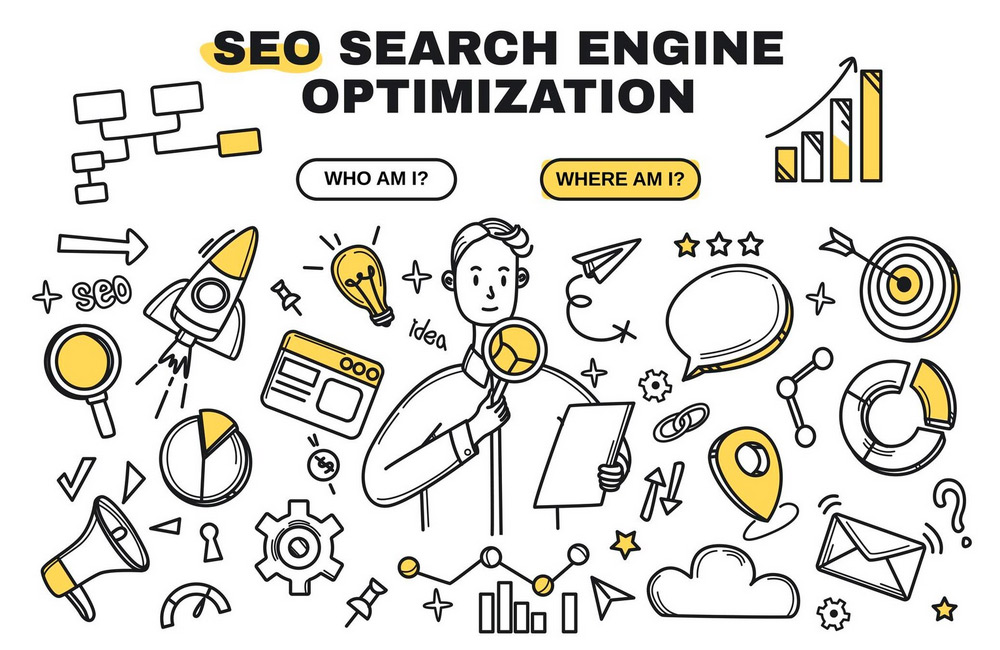Many designers focus on the visual aspects – aesthetics, colors, shapes, and layout. But great design alone is not enough if the website isn’t found on Google. Good web design and SEO go hand in hand: beauty meets structure, aesthetics meets discoverability. Behind every strong brand is a website that not only impresses but performs. Those seeking visibility, trust, and reach should combine both: design for humans, structure for machines. Here’s how to build your designs so they delight both users and search engines.
1. Structure beats beauty
A clear, hierarchical structure is the foundation of any SEO-optimized website.
Use headings wisely (h1, h2, h3), avoid cluttered layouts,
and organize content so it is logical and easy to read – for both humans and search engines.
Clean structure helps visitors find what they’re looking for faster and stay longer.
Search engines analyze this order and rank pages with clear structure higher.
Good structure = better readability + better ranking.
When design and order work together, you create an experience that works visually and technically.
2. Mobile First is essential
Modern design must work on all devices. Google considers mobile usability a ranking factor. Focus on responsive design, sufficiently large buttons, readable font sizes, and a clear layout on smartphones and tablets. Over 70% of users browse on mobile devices today – if your site doesn’t work there, you lose reach and customers. Test regularly on different devices and screen sizes. Mobile First means: design for the small format first, then scale up. This ensures an intuitive, seamless, and welcoming experience no matter where someone opens your site.
3. Loading speed is part of design
A visually appealing design with large images or complex animations can become an SEO trap. Optimize images (e.g., using WebP format), minimize CSS and JavaScript files, and use caching to improve load times. A fast website retains users – and Google loves speed. Even a few seconds of difference can impact conversion or bounce rates. Reduce unnecessary elements and keep your designs lightweight, clear, and responsive. Performance isn’t just a technical detail; it’s part of the design.
4. Don’t forget text
Visual design should never overshadow content. Google cannot “see” images; it understands text. Include meaningful copy, subheadings, and relevant keywords in context. Design should support – not hide – content. Every text section is an opportunity to convey your message and reinforce your topic. Align imagery and wording to create a harmonious overall presentation. A design without content is like a shop window without products: pretty, but empty.
5. Integrate meta tags & alt texts
Designers who take SEO seriously also pay attention to details: meta title, meta description, and alt texts for images. These elements help Google understand your page and improve click-through rates in search results. Each alt text acts like a description for blind search engines – making images “readable.” Meta tags are invisible bridges between design and discoverability. Used correctly, they create a strong foundation for your entire web project.
6. User experience = SEO success
SEO starts with user experience. If visitors can navigate easily, stay longer, and click more, Google signals: this page is valuable. Design intuitively, use clear call-to-actions, and guide visitors through content. Clear structure, good contrast, and readable fonts increase dwell time. The better the user experience, the higher your ranking – a positive feedback loop. Always remember: Google ranks what people like.
7. Internal linking and structure
Link your content logically. Good internal linking helps search engines understand relationships and strengthens thematically related pages. Use descriptive URLs and logical menu items. Place links where they add value, not arbitrarily. This creates a living network of knowledge that guides users and is loved by Google. Every page should be part of a larger context – this makes your website organically strong.
8. Avoid excessive design
Complex animations, moving backgrounds, or sound effects can distract or impact performance. Minimalism works visually and technically, providing a focused user experience. Less is often more, especially when clarity and focus are the goals. Good design attracts through structure, contrast, and meaning, not effects. True elegance comes from calm, not sensory overload.
9. Designers & SEO experts: teamwork matters
Those building websites shouldn’t see SEO as a tedious add-on. The best results come when designers, developers, and SEO specialists collaborate. Aesthetics and visibility become a harmonious whole. Working together allows design ideas to be combined with data – finding creative solutions that work. This synergy produces projects that are emotionally engaging and measurably successful. Design & SEO = art & strategy in balance.
Conclusion
Design is communication – and SEO is the language Google understands. By combining both, you create websites that are beautiful and visible. You speak to two worlds: humans and machines. In the end, what matters is that your design is not only seen but found and loved. Beauty impresses, but visibility endures.
Further Resource:
A full list of the well-known 200 Google ranking factors can be found here:
https://backlinko.com/google-ranking-factors
Image: freepik.com

